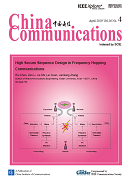COMMUNICATIONS THEORIES & SYSTEMS
Tianqi Zhang, Ming Chen, Xianglin Wei, Bing Chen, Chao Hu
2019, 16(4): 59-74.
As a promising technology to completely transform how we architect, deploy, operate and manage various networks, software-based Network Function Virtualization (NFV) enables hardware-independent, flexible, fast and efficient network service provision. With the increasing popularity of NFV paradigm, the Internet has also transformed to be a hybrid environment where NFV-based network entities coexist with traditional network devices. To facilitate our understanding, design, evaluate and manage of such novel network environment, there is a great need for a new NFV-compatible network measurement system which is still in absent so far. To bridge this gap, a system, named Software Defined Network Measurement System (SDNMS), is presented in this paper. Firstly, the architecture of SDNMS is proposed. In this architecture, a formal method to describe the working mode of the network measurement is defined. This method can also be utilized to generate a network measurement middle box (NMMB) in a specific location of the NFV network according to the customized description file, and to flexibly deploy the network measurement function. Secondly, the technology of virtual network measurement function (VNMF) combined with LXC is studied to form NMMB function. Thirdly, a control method is presented to control the start, stop, and update NMMB to form a specific network measurement system function. Finally, a prototype of SDNMS with network monitoring function to monitor network performance anomalies and locate faults is introduced. Experimental results have shown that SDNMS architecture and related technologies are feasible and effective to deploy and control network measurement functions in NFV networks. We hope SDNMS could provide a new method for practitioners to conduct network management and research at the age of NFV.
